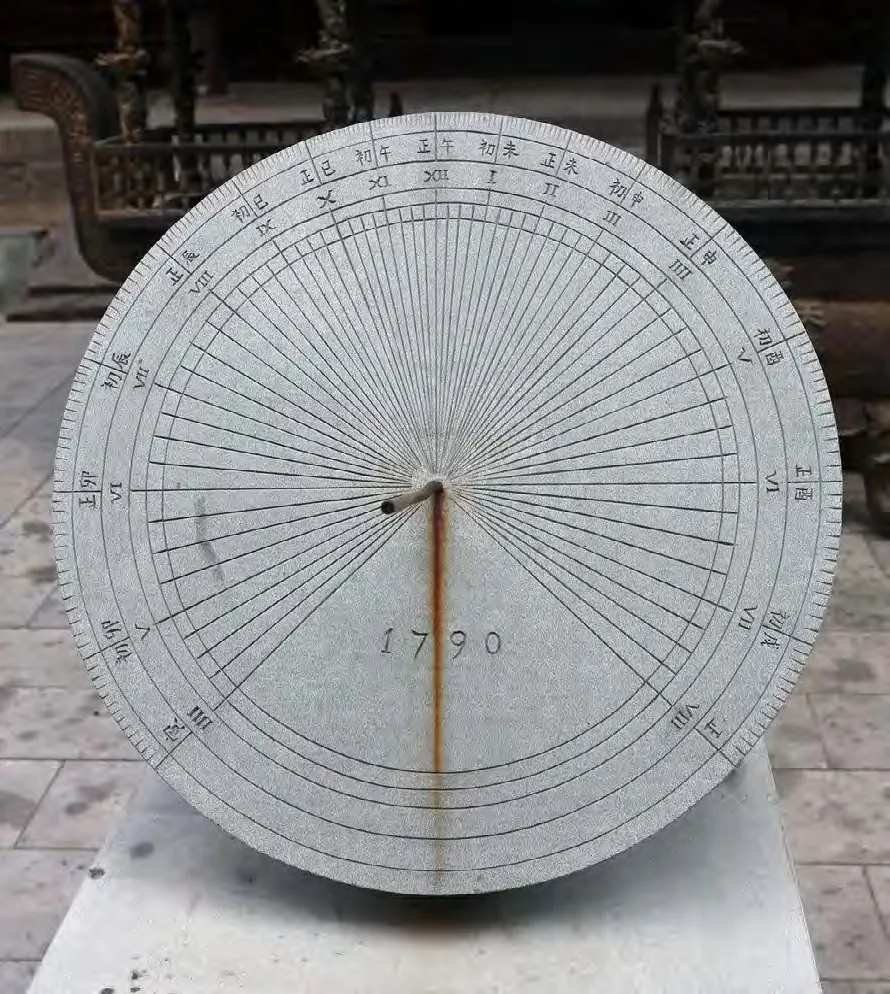How Cultural Relics Were Discovered
2018-08-03ByShuYi
By Shu Yi
How are discoveries made? I would like to cite two examples from my own experience.
I once went to the old Cishan Temple in the Tiantai Mountain in Shijingshan District. As I walked, my foot inadvertently kicked a stone. I carefully looked at the round stone which just happened to be an ancient sundial engraved with numbers. A needle was inserted in it, pointing at the south. The shadow cast by the needle indicated the time.
That stone was the plate of a sundial, but no one had noticed it,let alone discovered its value.
“1790” was carved on the plate,which aroused my curiosity. If the sundial was from ancient China,it should have used the year numbering system used in ancient China, such as Year of Yihai during Qianlong’s reign, instead of “1790.”
I then took a closer look at it and found hours on it. In ancient China, a day was divided into 12 two-hour periods indicating the names of 12 Earthly Branches,such as Zishi (23:00-24:59 at night) and Maoshi (5:00-6:59 in the morning). However, on the sundial there were 24 hours marked in the Roman alphabet. It was extremely rare for the Roman alphabet to have been used during Qianlong’s reign.
It was extraordinary! At that time, Western missionaries brought to China the Western calendar which was then combined with the Chinese calendar, and thus this special object came into being. It was an amazing cultural relic which was evidence of cultural exchanges between the East and West.
Later, I wrote an article about it, titled “The Foreign Sundial,”which attracted considerable attention. Now, the object has become part of a museum’s collection.
The second story also occurred in Shijingshan District. On Moshikou Street in the scenic area, there was an ancient temple from the late Ming Dynasty, called the Cheng’en Temple.
When I visited the temple, I found two dark murals on the wall of the Hall of Heavenly Kings.There were four murals in the hall.

慈善寺 The Cishan Temple
文物这样被发现
文/舒乙
什么叫发现问题?我举两个我自己经历过的例子。
有一次,走到石景山区,那里有一个破庙叫慈善寺,在天台山里头。正走着,踢到一块石头,我仔细端详这块石头,是一个古代的日晷:一块圆的石头,上面刻上数字,然后插一根针,对着正南方,这个针的阴影就是当时的时间。
这块石头是一个日晷的盘面,没有人去注意它,更没人发现它的价值。
盘面上雕着“1790”。这个“1790”引起了我极大的好奇。如果日晷是古代的,它肯定用中国古代纪年法,比如说乾隆乙亥年,不会写1790年。
再仔细一看,那上头记的是小时。中国古代讲时辰,十二地支记时,比如子时、卯时,这里的“时”相当于现在两个小时。它那上头记的是二十四小时,且标的数字是罗马字母。乾隆时代用罗马字母,是非常稀罕的了。
这是一个不得了的东西!在那个时代,西方传教士把西方历法传到中国,然后和中国历法相结合,形成这样一个特殊物件。这是东西方文化交流的一个铁证,是一个不得了的文物。
后来,我把它写成一篇小文章,题目叫《洋日晷》,引起很大关注。现在,这个东西已经被收藏在博物馆里。
第二个例子也发生在石景山区。景区里有个明晚期古庙叫承恩寺,在模式口街。
我参观的时候,发现墙上有两块黑乎乎的壁画。它一共四幅,在天王殿里。
I asked the temple keepers and staff managing cultural relics about what was painted on the two dark frescos. They didn’t have a clue. I borrowed a flashlight from them to take a closer look and was stunned at my discovery.
These two incredible murals had been there for about 550 years, but no one recognized their great value. On the murals were painted the images of eight lifesized people, with the empress and the emperor on either side.With a water container in her hands, the empress was pouring water and fish into the river. She was freeing the fish. The emperor was releasing a bird from his hand, and a maid was carrying a birdcage. These were actually two murals about freeing fish and captive birds.
Near this temple, there is a major historical and cultural site protected at the national level,called the Fahai Temple, where there are wonderful murals of Avalokitesvara and gods dating from the Ming Dynasty. The aforementioned two murals were created a bit later than those at the Fahai Temple dating back to the Ming Dynasty, but were of the same style, which proved that they were painted by the emperor’s own painter.Through images from heaven to earth, these murals reflect the Buddhist philosophy, as well as the forward-thinking concepts of protecting the Earth, caring for life, and maintaining a harmony between man and nature.

洋日晷 The Foreign Sundial
I wrote an article about the surprising presence of these wonderful murals at the Cheng’en Temple on the outskirts of Beijing. The State Administration of Cultural Heritage organized an assessment as soon as they read my article, and the status of the Cheng’en Temple was upgraded to that of a nationally protected major historical and cultural site.
(From Series 1, Huiyuan Lecture Hall, University of International Business and Economics Press. Translation:Chen Jia’ni)
我问看庙的人和文物方面的管理人员,这两幅画画的是什么,他们说不知道。我向他们借了一个手电筒,要仔细看看。
一看吓我一跳,两幅非常棒的壁画让我给发现了。五百五十年来,竟然没有人发现它们的价值。画上画的是八个人,都是真人大小,一边是皇后,一边是皇帝。皇后手里拿着盛水的容器,往河里倒水和鱼,她在放生。皇帝托着一只小鸟在放飞,宫女给他拿着鸟笼子。这实际上是两幅放生图。
在这个庙附近,有一个国家重点文物保护单位法海寺,那里有明代壁画,有观音,有神仙,非常精彩。这两幅画从时间上来看,比法海寺明代壁画稍微晚一点,但风格相同,证明是皇帝的画师画的。这些画从天上到人间,看似在宣扬佛教理念,但其中关爱生命、人与自然和谐相处的意识,实则非常超前的。
我写一篇文章,说精彩壁画惊现京郊承恩寺。文章被国家文物局看见后,立刻组织评定,将承恩寺定为国家重点文物。

承恩寺 The Cheng’en Temple
